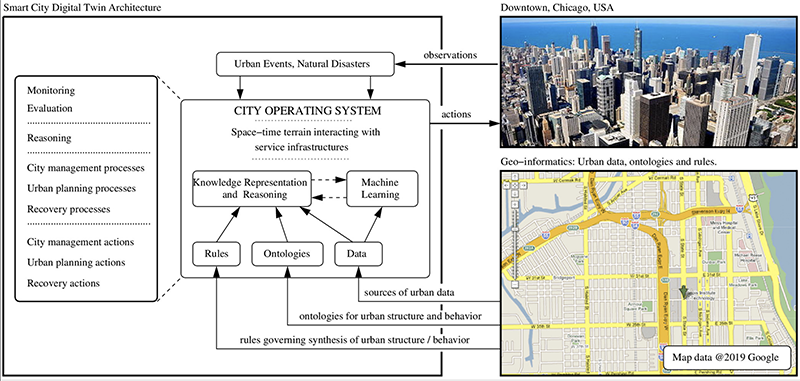News Story
A combined semantic and machine learning approach for smart city digital twins

Fig. 2 from the paper: Smart city digital twin architecture and operating system view of smart city behaviors, management of city and urban planning processes and actions, and restoration of operations in response to disruptions [Downtown Chicago Image: Andrew Horne, under Creative Commons-BY_2.0 license]
Cities are moving towards widely adopting embedded sensing, processing and data technologies within their buildings, transportation systems, electrical grids, water and sewer systems, and other physical infrastructures. These technologies, when connected to each other, enable the idea of a “smart” city. In a smart city, humans can use software and algorithms to analyze information provided by these networks to enhance urban performance, resilience, planning and efficiencies.
One term being used in this smart city scenario is “digital twin,” the cyber mirror of the physical urban system that is created through the real-time monitoring and synchronization of the participating technologies.
An article just published in the July 2020 issue of the Journal of Management in Engineering explores the approaches and challenges of architecting and operating smart city digital twins. “Architecting Smart City Digital Twins: Combined Semantic Model and Machine Learning Approach,” was written by Associate Professor Mark Austin (CEE/ISR); Alumna Parastoo Delgoshaei (Civil Systems Ph.D. 2017), now a research engineer at NIST; Civil Systems Ph.D. student Maria Coelho; and Mohammad Heidarinejad, Assistant Professor in the Department of Civil, Architectural and Environmental Engineering at the Illinois Institute of Technology. Austin advised Delgoshaei and currently advises Coelho.
In this paper, the authors envision a city operating system that provides stakeholders such as residents, government officials, businesses, planners, and engineers with enhanced levels of situational awareness and decision-making support to manage urban infrastructure and services.
To move towards the goal of smart city digital twin architecture, the authors build on their recent work in semantic modeling for urban system of systems and their exploration of a combined semantic and ML approach to the monitoring of energy consumption in buildings. They propose a path that supports semantic knowledge representation and reasoning, as well as machine learning formalisms, to provide complementary and supportive roles in collecting and processing data, identifying events, and automating decision making. This process of continual learning includes progressive refinement of semantic models and data-driven discovery of cause-and-effect relationships and hidden patterns among elements of the participating domains. A case example of a problem involving simplified analysis of energy usage in buildings located in the Chicago metropolitan area is included.
Published April 20, 2020








